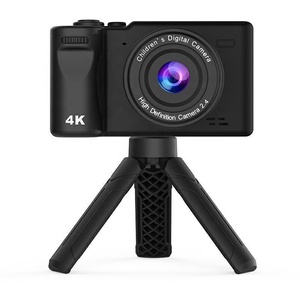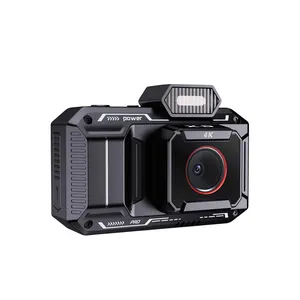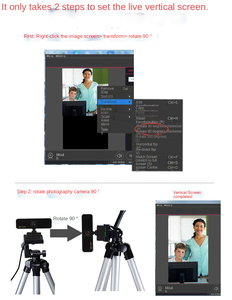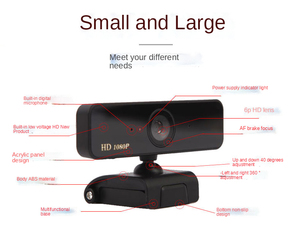Types of the Video Cameras
Video cameras or camcorders are designed to capture moving images on tape or digital media. There are different types of cameras, each varying in size and purpose.
- Digital Camcorders: These video cameras are for professional video shoots. They have large sensors that improve the camera's ability to gather light, resulting in better-quality videos. Digital camcorders also have a greater resolution, starting from 4k, which makes videos clearer and sharper. These video cameras often have accessories like external microphones for better audio quality during professional video shoots and larger memory card slots to accommodate high-capacity cards for extended recording times. Professional-grade video cameras like the Canon XA series offer advanced features tailored to professional videography, including dual memory card slots for backup and extended recording and extensive manual controls for full creative control over exposure, focus, and audio settings.
- DSLR & Hybrid Cameras: DSLR and hybrid cameras can also serve as video cameras if needed. They have larger sensors, which help improve video quality. Hybrid cameras, also known as mirrorless cameras, offer numerous benefits, including superior autofocus systems crucial for smooth and precise focus shifts in video footage, faster burst shooting speeds for capturing multiple frames per second, and advanced in-body stabilization systems that minimize camera shake during handheld shooting, ensuring steady and professional-looking video recordings. DSLR and hybrid cameras can also have video accessories like external microphones that improve audio quality and larger memory card slots that accommodate high-capacity cards for extended recording times.
- Action Cameras: Action cameras have small-sized video cameras. They are portable and user-friendly. Their small, lightweight design allows for easy portability and convenience. Action cameras are also rugged and waterproof, equipped with durable exteriors and waterproof casings or built-in designs that enable them to withstand exposure to water, dust, impact, and extreme temperatures. This ensures they can capture footage in challenging environments and under adverse conditions.
- Smartphone Cameras: The modern smartphone has also become a video camera. It can capture videos, especially with the right apps and accessories. While they may be less powerful than dedicated action cameras, smartphone cameras are often more accessible, convenient, and versatile for casual video recording.
Features and Functions
The features of video cameras are as follows:
- Image Sensor: A video camera's image sensor significantly impacts the video quality. Sensors with higher resolutions provide sharper and more detailed videos. Many cameras for professional use have large sensors that can record in 4K or higher resolutions. Higher-end options may even have full-frame sensors like those found in DSLR stills cameras. A video camera with a high-quality sensor can improve low-light performance and produce a film-like 'bokeh' effect. This is where the background gets blurred, making the subject stand out. It gives users more creative control over how their videos look.
- Lenses: A good lens can make videos look much better. Many video cameras have zoom lenses built-in to allow users to get closer or farther away from their subject. Zooms go from wide angles that show more of the scene to close-ups that highlight details. Some more advanced cameras let users add or change lenses based on what they need. Looking through a wide-angle or telephoto lens can create different effects. Lenses with a lower f-stop number (like f/2.8) let in more light, which is better in dark places. High-quality lenses also take sharp and clear pictures while reducing unwanted light problems.
- Microphone: A camera's microphone is essential for capturing good-quality audio to accompany the video footage. Most camcorders come with built-in microphones, but their sound recording capabilities may often be limited. Higher-end models offer the option to connect an external shotgun or lavalier microphone for improved sound fidelity. Dedicated audio recording devices such as muffled voice recorders can also be synced with the camera during post-production editing via shared timecode or jam-synced clocks. When possible, recording audio separate from that captured by the camera microphone is best from a professional standpoint.
- Display: The LCD display is critical for framing shots, reviewing recorded footage, and navigating settings. It enables users to monitor audio levels, battery life, recording duration, and other vital information during shooting. Higher-resolution screens provide a more accurate visual representation of the scene. Flip-out or touchscreen displays offer additional flexibility when positioning the camera. A viewfinder can also be useful for composing shots, especially in bright conditions where the LCD may be challenging to see clearly. A decent-sized screen significantly aids the recording process.
Applications of Vidio camera
A video camera lets users capture and share life's moments, whether personal videos, blog content, education, or media.
- Professional filmmaking: High-end video cameras are instrumental in professional filmmaking for creating movies, TV shows, and commercials. These cameras provide filmmakers with high-resolution footage, advanced features, and exceptional image quality.
- Television production: Video cameras are essential for recording and broadcasting television shows, news reports, sports events, and documentaries.
- Live events and broadcasting: Video cameras are used to capture concerts, conferences, webinars, and other live events for broadcasting or streaming purposes.
- Amateur filmmaking and vlogging: Video cameras can also be used by amateur filmmakers to create short films, music videos, or other creative projects. Additionally, vlogging cameras with built-in video recording capabilities have gained popularity among online content creators who want to document their lives or share tutorials on social media platforms.
- Documentary production: Documentary filmmakers rely on video cameras to capture real-life stories, interviews, and events for their projects.
- Education and training: Video cameras are used in classrooms, training centers, and workshops to record lectures, demonstrations, and practical exercises for future reference. Online courses and educational platforms also use video recordings as learning materials.
- Security and surveillance: Video cameras play a crucial role in monitoring and protecting premises for security purposes. CCTV cameras and other surveillance systems help businesses and homeowners ensure safety and prevent theft or vandalism.
- Sports and recreation: Action cameras are popular among adrenaline seekers who want to record their adventures while skiing, surfing, biking, or engaging in other extreme sports activities. Sports camera gear is also beneficial for coaches and athletes during training sessions.
- Scientific research and exploration: Video cameras are used in various scientific fields to document experiments, field studies, and explorations. From microscopes with integrated cameras to rugged cameras for environmental monitoring, video technology is essential for advancing knowledge and discovery in science.
How to choose a video camera
Consider these factors when choosing the right video camera for needs.
-
Define applications and purposes:
Consider whether users are shooting artistic films, marketing videos, travel vlogs, or event coverage. Film school projects? Wedding videos? Defining areas of interest helps narrow options for video cameras.
-
Budget considerations:
Many cameras available under every price including 4K options. Additional expenses for lenses, tripods, lights, audio gear, and editing software. Allocate budget for accessories. Expanded storage and battery life are critical.
-
Image quality and resolution:
Resolution determines detail for large presentations. Explore options from HD to 4K. Higher frame rates offer smoother motion for slow motion playback. Select a camera meeting specified resolution and frame rate requirements.
-
Camera type and form factor:
Variety of camera types available today. DSLRs and mirrorless models with video capabilities offer rich video quality but may require more learning. Handycams and camcorders are great for beginners with less manual control. Action cameras excel at wide angles for outdoor sports. Smartphones have the ultimate point-and-shoot convenience.
-
Lensing and zoom capabilities:
Consider intended shooting style when choosing camera. Fixed lenses provide wide angles for vlogging, but as mobile. Interchangeable lens cameras allow lens swapping but are larger. DSLR and mirrorless models give the most zoom control but require time to master.
-
Low light performance:
Cameras differ in how well they shoot without other lighting. Larger sensors typically handle dark better. Larger apertures let in more light. Consider low-light capabilities if shooting at night or in dim spots.
-
Audio quality and input options:
Good video needs clear sound. Built-in mics often miss close conversations. Choose a camera with input for external microphones. Handheld recorders also link for better audio. Look for features that allow recording from audio mixing desks.
-
Stabilization features:
Footage from handheld cameras may appear shaky. Effective image stability makes this a must for moving shots. Check for built-in stabilization systems that correct small shakes while editing.
-
Battery life and storage capacity:
During long recordings, cameras need batteries and memory cards. Larger SD cards hold more and allow longer recording. Look for cameras using widely available SD or SDHC cards.
Q & A
Q: How much storage does a video camera need?
A: The storage requirement for a camera depends on the internal storage and whether it has an external memory card slot. Generally, 4K videos consume more space than those in lower resolutions. For example, an hour of 4K takes about 30 GB, while the same duration in Full HD takes approximately 6 GB. However, most video cameras have an external memory card slot where users can add up to 256 GB or more SD cards.
Q: How to edit videos from a video camera?
A: To edit videos from a video camera, connect the device to a computer using a USB cable or transfer the files via Wi-Fi. The footage should be copied to a designated folder on the computer. Then, launch a video editing software like Adobe Premiere Pro, Filmora, or any other. Import the footage into the software and use that program to manipulate the video as desired. This is done by adding music, making cuts, and including text, among other things. Finally, export the edited video from the software and share it as needed.
Q: How to upload videos from a video camera to YouTube?
A: To upload videos from a camera to YouTube, connect the device to a computer through a USB cable or transfer files via a memory card. Open a web browser and go to the YouTube site. Log in to the YouTube account, then click on the User icon. Select the Upload Videos option and choose to drag and drop the files or select them. Once the video is uploaded, fill in the title, description, and other information, then click on Publish when ready.



























































































































































































































